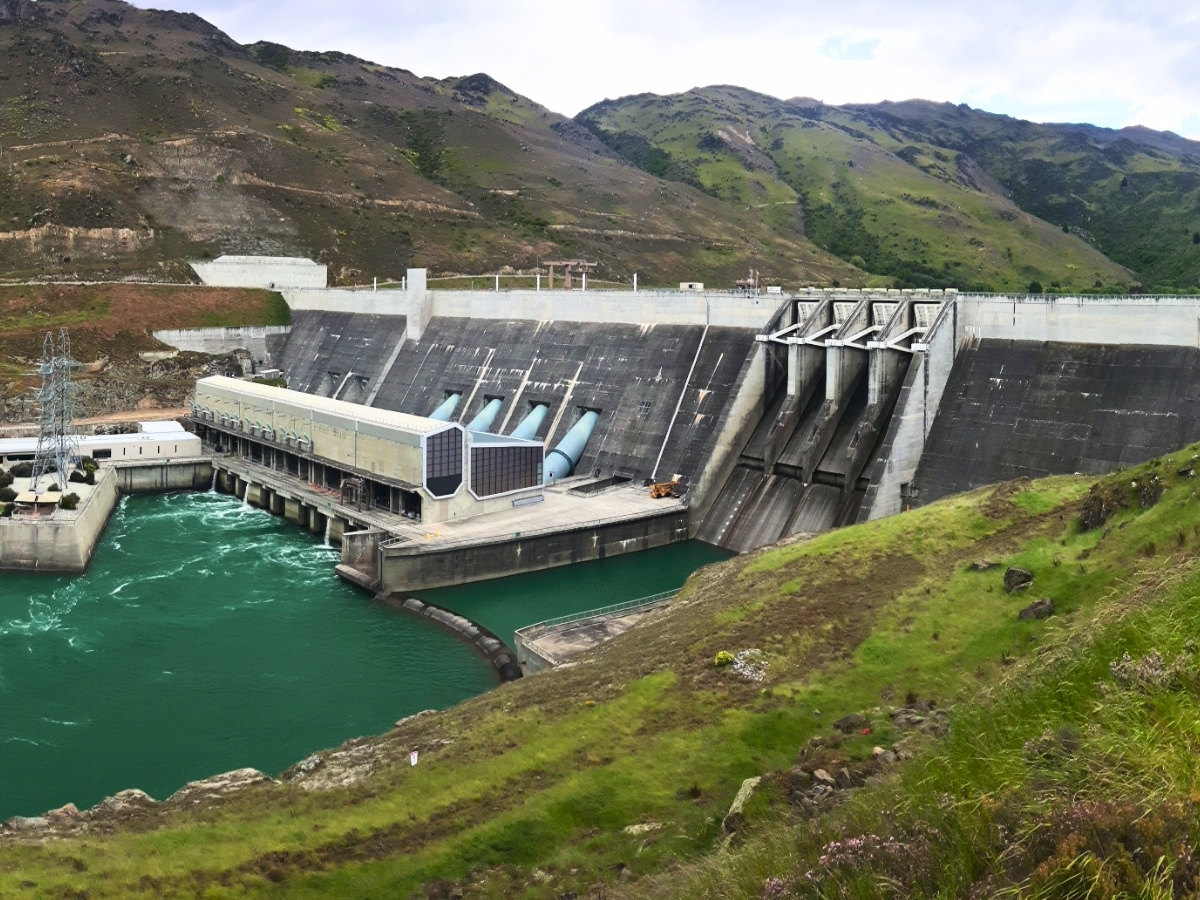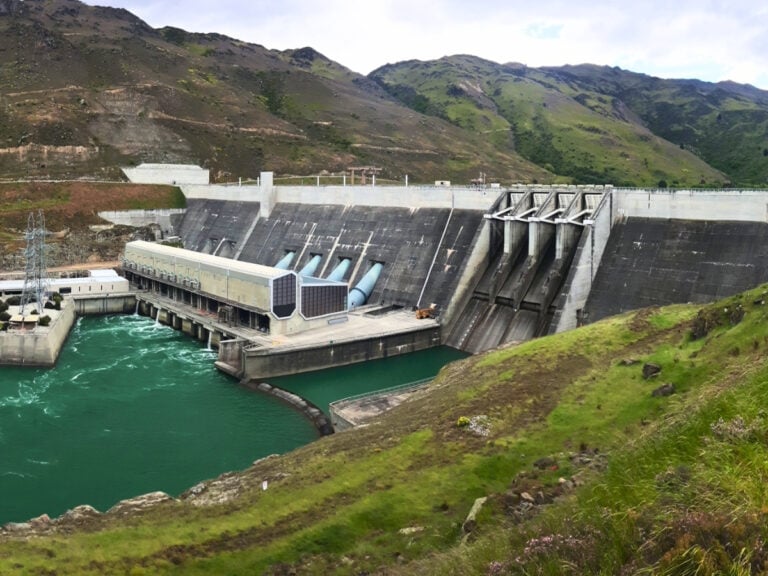
This huge electricity storage project could inspire France
Clyde Dam on the Clutha River / Image: Energy Revolution – HL.
The country is located 19,000 km from France. However, New Zealand can inspire France with its vast pumped storage electricity development (STEP) programme. The island nation, with a population 20 times smaller, plans to build a plant 27 times more powerful than all six French sewage treatment plants. Hair up.
to meet its energy needs, New Zealand It relies heavily on hydroelectric power. Thus, in 2019, hydroelectric power accounts for 57% of its annual production of 45 TWh. Combined with the North Island’s geothermal resources, it allows the country to position itself very favorably in renewable energies: in 2017 it ranked fourth among OECD countries, after Iceland, Norway and Sweden.
In 2016, the favorable year for hydro production, 84.8% of electricity was produced from renewable sources. To protect against the vagaries of the weather, New Zealand recently developed a project for a massive storage pumped power transmission plant (STEP) which will be capable of storing 5 TWh of electricity.
“drought years”
New Zealand benefits from a very favorable climate for hydropower, particularly on its South Island. Precipitation is abundant there, between as low as 600 mm/yr east of the Southern Alps and 1,600 mm/yr west of that assembly line that divides the island in two. These deposits are fairly regular throughout the year. In addition, the presence of these high mountains, sixteen of which are more than 3,000 meters in height, allows the formation of large stocks of snow, and the summer melt is also very beneficial for the regularity of hydroelectric power production.
However, hydropower is subject to climate variability. These differences are mitigated slightly in practice, due to the lower storage capacity of New Zealand hydraulic installations. At around 4.5 TWh, it represents only 20% of its annual electricity production. To ensure regular production of electricity, they need a regular supply of rain and melting snow from the Southern Alps.
Read also
In the bowels of a gigantic electricity storage station
Thus, when drought hits the South Island in certain years, the hydroelectric facilities have difficulties supplying the electricity grid at its usual level. To ensure grid balance, New Zealand then uses thermal power plants, which primarily consume natural gas. As a result, 30% of the natural gas consumed by the archipelago is intended to compensate for fluctuations in the hydraulic source, at about 17 TWh per year.
Droughts are more problematic as they are more likely to occur during the cooler months; Part of the precipitation is already trapped as ice and snow in the mountains. These dry periods therefore coincide with a period of high demand for electricity, when it is then necessary to heat the buildings.
These problematic years are called “drought years” by the New Zealand government. These dry years are unpredictable, and they occur at a rate of about twice per decade; The most recent years identified are the years 1992, 2001, 2003 and 2008. Analysis of hydraulic flow records for the past 89 years showed that energy deficits could rise to values of between 3 and 5 TWh during the worst years, approximately 10% of electricity mix needs.
Read also
Pharaonic electricity storage projects launched by Australia
Onslow Lake Wastewater Treatment Plant Project
This observation led the New Zealand government to launch the New Zealand Battery Project, under the auspices of the Ministry of Business, Innovation and Employment (MBIE). The term “battery” is understood here in a (very) broad sense, since it includes a wide range of projects of a very diverse nature: demand regulation, renewable expansion, supply of thermal power plants with biofuels (mainly wood), hydrogen storage, and privately pumped storage. .
For the record, pumped storage refers to an installation consisting of two water basins located at two different heights, connected by a tunnel where reverse turbines are located. When it is necessary to supply electricity to the grid, the turbines allow water to pass from the upper basin to the lower basin, thus generating electricity as in a conventional hydroelectric installation. When surplus electricity is available on the grid, these turbines operate in reverse in pump mode, lifting water from the lower basin to the upper basin.
This water will then be available to generate electricity later. It is therefore a storage system for electricity, which has a completely different process than a battery, but has the same concern as the electrical grid. With regard to this option, the preferred site so far is an extension of the Lake Onslow Reservoir by a Transfer Pumped Energy Plant (STEP). This lake is located on the South Island, in the Otago region, near the town of Roxburgh.
Plan for the Future / Image: New Zealand Department of Business, Innovation and Employment.
The studies are being conducted by the engineering consortium Te Rōpū Matatau, led by Mott MacDonald. The first phase of these studies took place from December 2020 to December 2022, and has just been completed. Demonstrates the feasibility of such an installation.
First of all, the space is sufficient around Lake Onslow, because it makes it possible to think of storing a large amount of water at a height: storage from 3 to 8.5 TWh is possible, and thus makes possible the guarantee of the need for the aforementioned 5 TWh. The land is also able to support the necessary dam.
Various tunnel options make it possible to envisage up to six 250 MW pumping storage turbines, with a total capacity of 1.5 GW. The electrical grid, operated by Transpower, also includes high-voltage lines compatible with such an installation.
In terms of the water source, the Clutha/Mata or river is a sufficient water source, low enough for pumping water. Several low-draw sites are possible at the top and bottom of the Roxburgh Community Dam.
Read also
The 3 largest electricity storage sites in the world
It is estimated that construction and operation will take between 7 and 9 years. The total cost of the project, estimated on the basis of these preliminary studies, is NZ$15.7 billion, approximately €9 billion. Thus the cost per unit volume is around 1.8 EUR/MWh. By comparison, one of the largest batteries in the world, the Manattee project in Florida, has a capacity of 900 MWh at an investment cost of US$300 million, a unit cost of about €300/kWh.
The New Zealand Battery project has now begun its second phase, with the aim of conducting detailed economic assessments. The final investment decision is now scheduled for the end of 2024.
What are the prospects in France?
What about STEPs in France? France already has six major pumped storage facilities. The largest of them is the Grand’Maison Dam, located at an altitude of 1,700 meters in the Vaujany commune of Isère. The installed capacity of this dam is 1.8 GW for an estimated storage capacity of 53.7 GWh, which is 93 times less than the New Zealand project.
Overall, the six wastewater treatment plants in France represent a cumulative capacity of about 5 GW, which recovers 6 TWh/year. The total storage capacity is 184 GWh. In a 2013 report by the European Commission, Marcos Gemerno Gutierrez and colleagues estimated that the achievable potential in terms of storage capacity in France was about 5 TWh, equivalent to the Lake Onslow project in New Zealand.
Read also
The massive electricity storage project that France has put aside
However, Decree No. 2020-456 of April 21, 2020 related to multi-year energy programming sets the following objective: “Undertaking by 2028 storage projects in the form of pumping power stations, with the aim of developing a capacity of 1.5 gigawatts between 2030 and 2035.”which, not only proves capacity in the amount of energy, but can appear somewhat limited compared to potential.
The reasons are many and complex. The issue of dams is already a sensitive topic for public opinion. The experience of the Cevens dam, as well as the protests surrounding massive basin projects, may make it difficult to envision the huge investments needed in France for any pumped storage facility. In this context, the progress of the 5 TWh wastewater treatment plant project in New Zealand will allow us to learn the best lessons for such projects in France. Going further, the curious reader can consult Report of the Te Rōpū Matatau Consortium.

“Reader. Travel maven. Student. Passionate tv junkie. Internet ninja. Twitter advocate. Web nerd. Bacon buff.”

